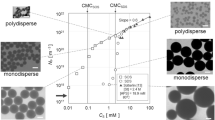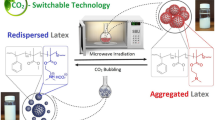Abstract
Aqueous dispersions of polymer nanoparticles (latexes) are of high commercial importance — it can be desirable to reversibly destabilize such latexes, for example, to enable transport/storage without the significant weight fraction of the water. In the present work, we have employed ab initio emulsion polymerization of methyl methacrylate with industrially relevant high solids content using mixtures of the anionic surfactant sodium dodecyl sulfate (SDS) and the photo-switchable cationic surfactant 2-(4-(4-butylphenyl)diazenylphenoxy)ethyltrimethylammonium bromide (C4AzoTAB). C4AzoTAB contains an azobenzene moiety that can undergo trans–cis isomerization triggered by UV light, the cis form being a less effective surfactant than the trans form. Rapid destabilization (sedimentation) could be achieved on exposure of the diluted latex to UV light using a continuous flow device, and subsequent redispersion was obtained on exposure to visible light, demonstrating reversibility of the process. The presence of the anionic SDS as well as judicious choice of the amphoteric initiator VA-057 play key roles in designing successful destabilization, with latex pH being of crucial importance.








Similar content being viewed by others
Availability of data and materials
Additional data available upon request.
References
Grady MC (2014) Latex technology. In Kirk‐Othmer Encyclopedia of Chem Technol 1–22
Lovell PA, Schork FJ (2020) Fundamentals of emulsion polymerization. Biomacromol 21(11):4396–4441
Thickett SC, Gilbert RG (2007) Emulsion polymerization: state of the art in kinetics and mechanisms. Polymer 48(24):6965–6991
Adachi Y, Xiao J (2013) Initial stage of bridging flocculation of PSL particles induced by an addition of polyelectrolyte under high ionic strength. Colloids Surf A 435:127–131
Gregory J (1976) The effect of cationic polymers on the colloidal stability of latex particles. J Colloid Interface Sci 55(1):35–44
Szilagyi I, Sadeghpour A, Borkovec M (2012) Destabilization of colloidal suspensions by multivalent ions and polyelectrolytes: from screening to overcharging. Langmuir 28(15):6211–6215
de Oliveira Cardoso AL, Galembeck F (1998) Polymer latex stability modification by exposure to hydrophobic solvents. J Colloid Interface Sci 204(1):16–23
Goddard ED (1986) Polymer—surfactant interaction part II. Polymer and surfactant of opposite charge. Colloids Surf A 19(2):301–329
Hersloef A, Sundeloef LO, Edsman K (1992) Interaction between polyelectrolyte and surfactant of opposite charge: hydrodynamic effects in the sodium hyaluronate/tetradecyltrimethylammonium bromide/sodium chloride/water system. J Phys Chem 96(5):2345–2348
Goossens JWS, Vogt HG (1990) The coagulation mechanism of heat sensitive latices. Colloids Surf A 51:129–139
Sekhar B (2007) Centrifugation of synthetic rubber latex. United States Patent Application Publication US20070293602A1
Guo HZ, Liu P, Li HM, Cheng C, Gao Y (2018) Responsive emulsions stabilized by amphiphilic supramolecular graft copolymers formed in situ at the oil-water interface. Langmuir 34(20):5750–5758
Brown P, Butts CP, Eastoe J (2013) Stimuli-responsive surfactants. Soft Matter 9(8):2365–2374
Darabi A, Jessop PG, Cunningham MF (2016) CO2-responsive polymeric materials: synthesis, self-assembly, and functional applications. Chem Soc Rev 45(15):4391–4436
Pinaud J, Kowal E, Cunningham M, Jessop P (2012) 2-(Diethyl)aminoethyl methacrylate as a CO2-switchable comonomer for the preparation of readily coagulated and redispersed polymer latexes. ACS Macro Lett 1(9):1103–1107
Su X, Jessop PG, Cunningham MF (2012) Surfactant-free polymerization forming switchable latexes that can be aggregated and redispersed by CO2 removal and then readdition. Macromolecules 45(2):666–670
Su X, Robert T, Mercer Sean M, Humphries C, Cunningham Michael F, Jessop Philip G (2013) A Conventional surfactant becomes CO2-responsive in the presence of switchable water additives. Chem Eur J 19(18):5595–5601
Delafresnaye L, Feist F, Hooker JP, Barner-Kowollik C (2022) Microspheres from light-a sustainable materials platform. Nat Commun 13(1)
Phommalysack-Lovan J, Chu YY, Boyer C, Xu JT (2018) PET-RAFT polymerisation: towards green and precision polymer manufacturing. Chem Commun 54(50):6591–6606
Zaquen N, Kadir A, Iasa A, Corrigan N, Junkers T, Zetterlund PB, Boyer C (2019) Rapid oxygen tolerant aqueous RAFT photopolymerization in continuous flow reactors. Macromolecules 52(4):1609–1619
Jung K, Boyer C, Zetterlund PB (2017) RAFT iniferter polymerization in miniemulsion using visible light. Polym Chem 8(27):3965–3970
Shi XB, Zhang J, Corrigan N, Boyer C (2021) PET-RAFT facilitated 3D printable resins with multifunctional RAFT agents. Mater Chem Front 5(5):2271–2282
Tomal W, Kiliclar HC, Fiedor P, Ortyl J, Yagci Y (2023) Visible light induced high resolution and swift 3D printing system by halogen atom transfer. Macromol Rapid Commun 44:2200661
Irshadeen IM, Truong VX, Frisch H, Barner-Kowollik C (2022) Red light induced folding of single polymer chains. Chem Commun 58(93):12975–12978
Eastoe J, Vesperinas A (2005) Self-assembly of light-sensitive surfactants. Soft Matter 1(5):338–347
Hayashita T, Kurosawa T, Miyata T, Tanaka K, Igawa M (1994) Effect of structural variation within cationic azo-surfactant upon photoresponsive function in aqueous solution. Colloid Polym Sci 272(12):1611–1619
Shin JY, Abbott NL (1999) Using light to control dynamic surface tensions of aqueous solutions of water soluble surfactants. Langmuir 15(13):4404–4410
Shinkai S, Matsuo K, Harada A, Manabe O (1982) Photocontrol of micellar catalyses. J Chem Soc, Perkin Transactions 2 (10):1261–1265
Jiang J, Ma Y, Cui Z, Binks BP (2016) Pickering emulsions responsive to CO2/N2 and light dual stimuli at ambient temperature. Langmuir 32(34):8668–8675
Mamane A, Chevallier E, Olanier L, Lequeux F, Monteux C (2017) Optical control of surface forces and instabilities in foam films using photosurfactants. Soft Matter 13(6):1299–1305
Takahashi Y, Fukuyasu K, Horiuchi T, Kondo Y, Stroeve P (2014) Photoinduced demulsification of emulsions using a photoresponsive gemini surfactant. Langmuir 30(1):41–47
Takahashi Y, Koizumi N, Kondo Y (2016) Active demulsification of photoresponsive emulsions using cationic-anionic surfactant mixtures. Langmuir 32(3):683–688
Jasinski F, Guimaraes TR, David S, Suniary C, Funston T, Takahashi Y, Kondo Y, Zetterlund PB (2019) Reversible destabilization of UV-responsive polymer particles (latex) using a photoresponsive surfactant. Macromol Rapid Commun 40(22)
Asua JM (2014) Challenges for industrialization of miniemulsion polymerization. Prog Polym Sci 39(10):1797–1826
Landfester K (2009) Miniemulsion polymerization and the structure of polymer and hybrid nanoparticles. Angew Chem-Int Ed 48(25):4488–4507
Oliveira MAM, Boyer C, Nele M, Pinto JC, Zetterlund PB, Davis TP (2011) Synthesis of biodegradable hydrogel nanoparticles for bioapplications using inverse miniemulsion RAFT polymerization. Macromolecules 44(18):7167–7175
Alam MN, Zetterlund PB, Okubo M (2006) Network formation in nitroxide-mediated radical copolymerization of styrene and divinylbenzene in miniemulsion. Macromol Chem Phys 207(19):1732–1741
Guo Y, Liu JQ, Zetterlund PB (2010) Nitroxide-mediated radical polymerization in miniemulsion on the basis of in situ surfactant formation without use of homogenization device. Macromolecules 43(14):5914–5916
Zetterlund PB, D’Hooge DR (2019) The nanoreactor concept: kinetic features of compartmentalization in dispersed phase polymerization. Macromolecules 52(21):7963–7976
Arya P, Jelken J, Lomadze N, Santer S, Bekir M (2020) Kinetics of photo-isomerization of azobenzene containing surfactants. J Chem Phys 152(2)
Author information
Authors and Affiliations
Contributions
P.B.Z. and Y.K. came up with the initial concept, which was further developed by T.R.G. Experimental work was conducted by R.O. and R.M. under close supervision by T.R.G. Y.T. prepared the responsive surfactant. Manuscript writing was conducted by R.O., T.R.G., and P.B.Z. All authors contributed to data analysis and discussions throughout the project.
Corresponding authors
Ethics declarations
Ethical approval
Not applicable.
Competing interests
The authors declare no competing interests.
Additional information
Publisher's Note
Springer Nature remains neutral with regard to jurisdictional claims in published maps and institutional affiliations.
Supplementary Information
Below is the link to the electronic supplementary material.
Rights and permissions
Springer Nature or its licensor (e.g. a society or other partner) holds exclusive rights to this article under a publishing agreement with the author(s) or other rightsholder(s); author self-archiving of the accepted manuscript version of this article is solely governed by the terms of such publishing agreement and applicable law.
About this article
Cite this article
Guimarães, T.R., Othman, R., McKenzie, R. et al. Light-induced reversible destabilization of responsive latex particles prepared via high solids content emulsion polymerization. Colloid Polym Sci 301, 979–988 (2023). https://doi.org/10.1007/s00396-023-05105-1
Received:
Revised:
Accepted:
Published:
Issue Date:
DOI: https://doi.org/10.1007/s00396-023-05105-1




